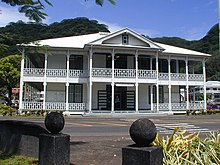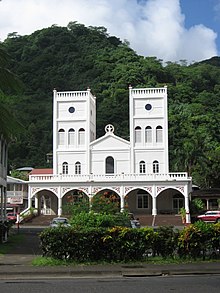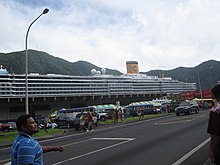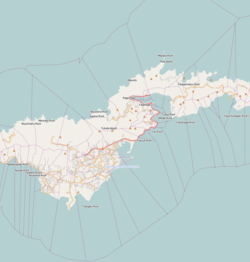Fagatogo, American Samoa
Fagatogo | |
|---|---|
Village | |
 | |
| Etymology:Samoan:faga ( "bay" ), togo ( "mangrove tree" ) | |
| Coordinates:14°16′45″S170°41′25″W/ 14.27917°S 170.69028°W | |
| Country | |
| Territory | |
| County | Maoputasi |
| Area | |
| • Total | 2.15 km2(0.83 sq mi) |
| Population (2020) | |
| • Total | 1,445 |
| • Density | 670/km2(1,700/sq mi) |
| Demonym | Fagatogan[1] |
| Time zone | UTC−11(Samoa Time Zone) |
| ZIP code | 96799 |
| Area code | +1 684 |
Fagatogois the downtown area ofPago Pago(the territorial capital ofAmerican Samoa).[2]Located in the low grounds at the foot ofMatafao Peak,it was the location of the first American settlement onTutuila Island.It includes the sub-village ofMalaloa.[3]Today, Fagatogo is the government, commercial, financial, and shipping center of Tutuila.[4]: 1 [5]It is also the administrative capital of American Samoa.[6]It is the location of theAmerican Samoa Fono(legislature), and is listed in theConstitution of American Samoaas the territory's officialseat of government.[7][8][9]Its population (as of April 1, 2010) is 1,737.
Fagatogo contains the Pago Pago port, the Pago Pago bus station and market, and theCo-Cathedral of St. Joseph the Workerof theRoman Catholic Diocese of Samoa-Pago Pago.[10]Fagatogo is also home to the governor's mansion, which sits on a hilltop just west of theRainmaker Hotelsite, in a section of Fagatogo calledUtulei.This colonial mansion was built in 1903, during the naval administration. The 1917Jean P. Haydon Museumis located a little further west. The old jail (built in 1911) and the police station sit just across the field fromthe Fono.[11]The architecture includes both 19th century clapboard buildings and newer, two-story, monotone concrete structures.[12]
The area aroundFagatogo Marketis considered the center of Pago Pago. Residents from all over the island travel to it by bus. Several landmarks are visible from the market:Mount ʻAlava,the canneries inAtu'u,Rainmaker Mountain(Mount Pioa), andPago Pago Harbor.[13]Immediately next to the Fagatogo Market is the Fagatogo Square Shopping Center, a 12,000-square-foot (1,100 m2) retail- and commercial center containing a number of large shops and restaurants.[14][15]Fagatogo is also home to the Pago Pago post office and the city's taxi services, museums, bars, and movie theaters.[2]
Fagatogo is recognized in American Samoa as having played the paramount role in the territory's political history. For example, it is where every agreement between theUnited Statesand American Samoa has been signed. It is jocularly called by some the "Washington, D.C.of American Samoa ".[16]: 2
Etymology
[edit]In theSamoan language,faga translates to “bay”, while togo means “mangrove tree.” Amangrove swampwas located in the village, which stretched fromFagatogo Marketto the fuel dock. At the beginning of the 20th century, mostmangrove treeshad been removed in order to make room for a new wharf and coaling station constructed by the U.S. Naval Administration.[16]: 5
History
[edit]



American interest inTutuila Islandbegan with theAmerican Samoan Treatyof 1878 which provided the United States with a non-exclusive right to establish a naval station on the Pago Pago Bay. The United States recognized the need to create a naval coaling station on the shipping route betweenHawai'iandNew Zealand,and shortly after the treaty proceeded to rent land inPago Pagoat $10 a month. In 1889, Rear Admiral L.A. Kimberly USN visited Tutuila and selected a site for a future U.S. naval station. Roughly 17 acres (6.9 ha) of land were purchased for a total price of $3,241.79. The construction of the wooden-floored steel dock, storehouse and manager's dwelling did not commerce for another ten years. A water reservoir in the hills behind the station was also constructed, and the expansion of the site begun by filling in Pago Pago Bay to the edge of the fringing reef. The Naval Station was made up of 8 acres (32,000 m2) on the shorefront as of 1907. The official U.S. Naval Station occupation began by the signing of the Deed of Cession by the High Chiefs on Tutuila- andAunu'uIslands and the raising of theUnited States Flagon April 17 in 1900. By the end of the navy administration period in 1951, the Naval Station occupied 216 acres (87 ha) and was made up of 105 structures. As of 2001, only twelve of the structures remained. Most remaining naval structures were entered onto theU.S. National Register of Historic Placesin 1988 as a part of theU.S. Naval Station Tutuila Historic District.[4]: 2
The naval commandant, ship's crew, and officers all originally lived on board the station ship. A concrete building was built near the station dock in 1902 serving as the first customs house. This structure was replaced by the present-day larger customhouse in 1920, which is located along the waterfront to the southwest of the station dock, known as Navy Building No. 67. This Customhouse, which measures 150 feet (46 m) by 80 feet (24 m), is located on the waterfront. As with other Naval Station buildings of this period, it was made of locally manufactured concrete blocks molded to imitate rough-cut stone. Until the introduction of the commercial air transportation in 1959, the Customhouse operated as the point-of-entry for all visitors to American Samoa. This was also the site of the territory's only execution, which took place in 1939 when a condemned murderer was hanged here.[4]: 4
The front portion of the present-dayJean P. Haydon Museumwas originally the Commissary Store, known asNavy Building No. 43,which was erected in 1919. The rear portion of the museum was originally a garage (Navy Building No. 24). When theDepartment of Interiortook over governance of American Samoa in 1951, the commissary in Fagatogo became thePago Pago Post Office.A new post office was constructed across theWilliam McKinley Memorial Highwayin 1971, and the former commissary and garage were consequently converted into a museum, named after the wife of GovernorJohn Morse Haydon.The west wing of the structure was extended in order to add an exhibit space, and a mural in front of the west wing was made by artistSven Ortquistand depicts a scene fromSamoan mythology.A traditional Samoanfalewas set up in front of the museum entrance.[4]: 4–6

Two 450-foot (140 m) high radio towers were situated where the present-day Historic District Pedestrian Park is found, near the historic Radio Station known asNavy Building No. 38.This building now serves as the Territorial Registrar's Office and was erected in 1917 duringWorld War I.The structure, which measures 60 square feet (5.6 m2), was the first to be built with faux-rock cement blocks. This building was altered in the 1970s in order to accommodateAmerika Samoa Bank.The present-day malae ( “Malae o le Talu” ), a large grassy area on the south side of the road, serves as the ceremonial center for City ofPago Pago.During the Navy days, it was known as the Parade Ground and was the site of training and performances by the Fita Fita Guard and Band. A small bandshell was found at the far end of the malae. The former Parade Ground, which measures 220 feet (67 m) by 500 feet (150 m), is now listed on the U.S. National Register of Historic Places and is part of theNaval Station Historic District.[4]: 6–7
Present-dayDepartment of Public Safety,which sits across from the malae, is a two-story white structure with an archedMission Revival-style first-floor veranda. This building was originally erected in 1908 by the Fita Fita Guard and was known was the Fita Fita Barracks (Navy Building No. 31). Immediately west of the former barracks is the former Samoan Jail (Navy Building No. 72), which now serves as offices ofInterpoland regional law enforcement agenciesOTICIDEandSPICIN.Although it remains unknown when the jail originally was built, it was in existence by 1917 when the United States went to war withGermany.During the war, the commandant seized two German ships inPago Pago Harborand detained the crews in the jail. The building is a one-story structure of poured, reinforced concrete, similar to the floor of the Fita Fita Barracks. It measures 50 square feet (4.6 m2).[4]: 7 and 10


Immediately west of the Samoan Jail facing the parade ground is the old Bake Shop, known as Navy Building No. 45. The commandant called for the construction of a new bakery in 1913, claiming the existing bakery was a disgrace to the station and unsanitary. The bakery was therefore constructed in 1919 in this one-story building measuring 40 square feet (3.7 m2). The present-day building now houses the Samoa Photo Express andWestern Union.Further down the main street on the bayside is the Maota Fono complex, now the home of theAmerican Samoa Legislature.The originalFonowas across the malae in a former Naval barrack, now home of theAmerika Samoa Bank.When the Fono burned down in 1970, the Fono consequently moved to its new structures in 1973.[4]: 10 and 12
Between present-day Scanlan's Inn and T&K General Merchandise is a cement path that leads up to theCatholic Co-Cathedral of St. Joseph the Worker.The cathedral was erected in 1959. A larger white church is situated slightly west of the malae, known as theCongregational Christian Churchor Key to the Kingdom of Heaven ( “O Le Ki O Le Malo O Le Lagi” ). Built on the former location of an olderLondon Missionary Societychurch, built in 1904. The cornerstone of this church was laid in 1933, but due to construction being interrupted byWorld War II,the church was not dedicated and completed until 1949. The church went through an extensive two-year renovation in 1994. In front of and slightly to the east is the refurbishedHigh CourtBuilding, originally known as the Naval Station Administration Building or Naval Building No. 21, constructed in 1904. When the structure was restored in 1998 at the cost of $1.2 million, much work was done to replicate the original exterior design and color scheme of the building. Much of the former interior woodwork was also preserved and restored, including the skylight and central staircase.[4]: 12–15
Demographics
[edit]
The population is more ethnically diverse than any other village in American Samoa. A majority of the village's residents are Samoans, attributed to the members of original families. Also, immigrants from places such asWestern Samoa,thePhilippines,Tonga,Fiji,South Korea,Europe,China,andmainland United Statesare residents of Fagatogo. The village had 1,737 inhabitants as of the2010 U.S. census,down from 2,096 which was recorded at the2000 U.S. census.Around 85% of the village's residents were under 50 years of age.[16]: 2 and 19
From 1980 to 1990, the population of Fagatogo grew from 1,944 to 2,323 inhabitants. The proportion of residents born outside of American Samoa was 23 percent in the early 1980s. This proportion increased to 41 percent between 1985 and 1990, and the proportion of residents born outside of American Samoa reached 52 percent in 1990.[17]
As of the2000 U.S. census,81.6% of Fagatogo's population were ofNative Hawaiian or Other Pacific Islandrace. 12.5% wereAsian,while 3.6% werewhite.[18]As of 2020, Fagatogo has a Hispanic population that is higher than the rest of the island (2.3% of Fagatogo vs. less than one percent of A.S. being Hispanic).[19]
Religion
[edit]Large churches include theCongregational Christian Church in American Samoa(CCCAS) and aRoman Catholic Church.TheMethodistChurch,Congregational Christian Church in Samoa,and other denominations are present on a smaller scale.[16]: 21 Congregational Church of Jesus in Samoa(CCJS)
Economy
[edit]

Fagatogo is the most developed village onTutuila Islandand the center of trade. Most of the village's original families carry on with traditional ways and depend on land and sea for daily needs. Others are employed with theGovernment of American Samoaor have positions within the legislature, executive or judicial branches. Homes are located on hills and mountain slopes where the land is fertile and ideal for planting fruit trees and vegetables. All types of produce are available at theFagatogo Market.[16]: 21–23
Fagatogo Square houses private businesses and government offices, as well as eateries and shops.[14]This mall is next-door to the Fagatogo Market, which is located in an area known as the center of Pago Pago. It is home to several restaurants, shops, bars, and often live entertainment and music. Souvenirs are often sold at the market when cruise ships are visiting town. Locals also sell handmade crafts at the dock and on the main street. Mount ʻAlava, the canneries inAtu'u,Rainmaker Mountain(Mount Pioa), andPago Pago Harborare all visible from the market. The main bus station is located immediately behind the market.[20][13]The Luman’ai Building houses thePago Pago Post Officeand various business offices. Pago Pago's museum, movie theater, bars, and taxi services are all located in Fagatogo, which is known as DowntownPago Pago.[2]
Sadie Thompson Inn,which is named for a character inRain(1921), is also in Fagatogo (Malaloa). This was the site where English authorW. Somerset Maughamresided during his visit to Pago Pago in December 1916.[21]It is currently a bed and breakfast inn. It was listed on theU.S. National Register of Historic Placesin 2003.
Sports
[edit]TheFagatogo Blues Rugby Teamhas held the main shield for theAmerican Samoa Rugby Union’s Annual Tournament for a number of years. Fagatogo is a regular competitor in the yearlyFautasiRace, held during theFlag Daycelebrations and Moso'oi Festival. Female residents established theFagatogo Teine o le Malaeoletalucricket team. The team held the championship title in women's cricket for numerous seasons.[16]: 19
Places of interest
[edit]- High Court of American Samoa,designatedhistoric districtand listed on theU.S. National Register of Historic Places
- Fagatogo Square
- Fagatogo Market
- U.S. Naval Station Tutuila Historic District
- Navy Building 38,listed on the U.S. National Register of Historic Places
- Jean P. Haydon Museum,listed on the U.S. National Register of Historic Places
- Sadie Thompson Inn,listed on the U.S. National Register of Historic Places
- Co-Cathedral of St. Joseph the Worker
Notable people
[edit]- Bob Apisa
- Lutu T. S. Fuimaono[22]
- Mike Gabbard
- John Kneubuhl
- Tuiasosopo Mariota
- Sa'eu Scanlan
- Faoa Aitofele Sunia
- Tauese Sunia
- Napoleon Andrew Tuiteleleapaga
- Galeai Moaaliitele Tuufuli
- Maiavaaitu Oliva Hunkin,member of theAmerican Samoa House of Representativesand Director of Port Administration.[23]
- Dr. Julia Lyons,professor at theUniversity of Oregonand Chief Pediatrician at theLBJ Tropical Medical Center(LBJTMC).[24]
- Fred Urhle,first Samoan department director in the Navy administration.[25]
See also
[edit]References
[edit]- ^Gray, John Alexander Clinton (1980).Amerika Samoa.Arno Press. Page 95.ISBN9780405130380.
- ^abcGrabowski, John F. (1992).U.S. Territories and Possessions (State Report Series).Chelsea House Pub. Page 51.ISBN9780791010532.
- ^Krämer, Augustin (2000).The Samoa Islands.University of Hawaii Press. Page 440.ISBN9780824822194.
- ^abcdefghEnright, John (2001).A Walking Tour of Historic Fagatogo: Tutuila, American Samoa.American Samoa Historic Preservation Office.
- ^Leib, Amos Patten (1972).The Many Islands of Polynesia.Schuster Merchandise &. Page 61.ISBN9780684130101.
- ^Lansford, Tom (2019).Political Handbook of the World 2018-2019.CQ Press. Page 1730.ISBN9781544327112.
- ^"Revised Constitution of American Samoa".asbar.org. Archived fromthe originalon June 7, 2007.RetrievedNovember 24,2010.
- ^Districts of American,statoids,retrieved2008-04-26
- ^Explanation of Listings: Country overview,statoids,retrieved2008-04-26(See the discussion,"What is the capital of X?")
- ^"Co-Cathedral of St. Joseph the Worker".Giga Catholic.Retrieved2013-05-21.
- ^Stanley, David (1999).South Pacific Handbook. David Stanley.Page 443.ISBN9781566911726.
- ^Stuart, Peter C. (1999). Isles of Empire: the United States and its Overseas Possessions. University Press of America. Page 54.ISBN9780761813118.
- ^abStanley, David (1999).Moon Handbooks Tonga-Samoa.David Stanley. Page 168.ISBN9781566911740.
- ^ab"Pago Pago".
- ^Goodwin, Bill (2006).Frommer’s South Pacific.Wiley. Page 405.ISBN9780471769804.
- ^abcdefFai’ivae, Alex Godinet (2018).Ole Manuō o Tala Tu’u Ma Fisaga o Tala Ave.Amerika Samoa Humanities Council.ISBN9781546229070.
- ^http:// botany.hawaii.edu/basch/uhnpscesu/pdfs/sam/Pedersen2000vol2AS.pdf(Page 24-22)
- ^Census of population and housing (2000): American Samoa Summary Social, Economic, and Housing Characteristics(2000). DIANE Publishing. Page 147.ISBN9781428985490.
- ^"P1TOTAL POPULATION".U.S. Census Bureau.
- ^"Fagatogo Market | American Samoa Attractions".
- ^Rogal, Samuel J. (1997).A William Somerset Maugham Encyclopedia.Greenwood Publishing Group. Page 244.ISBN9780313299162.
- ^Sunia, Fofō Iosefa Fiti (2001).Puputoa: Host of Heroes - A record of the history makers in the First Century of American Samoa, 1900-2000.Suva, Fiji: Oceania Printers. Page 79. ISBN 9829036022.
- ^Sunia, Fofō Iosefa Fiti (2001).Puputoa: Host of Heroes - A record of the history makers in the First Century of American Samoa, 1900-2000.Suva, Fiji: Oceania Printers. Page 82. ISBN 9829036022.
- ^Sunia, Fofō Iosefa Fiti (2001).Puputoa: Host of Heroes - A record of the history makers in the First Century of American Samoa, 1900-2000.Suva, Fiji: Oceania Printers. Pages 79-80. ISBN 9829036022.
- ^Sunia, Fofō Iosefa Fiti (2001).Puputoa: Host of Heroes - A record of the history makers in the First Century of American Samoa, 1900-2000.Suva, Fiji: Oceania Printers. Page 175. ISBN 9829036022.


